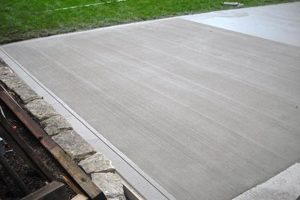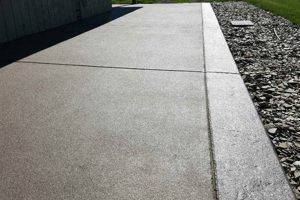Exterior flooring surfaces crafted from a cement-based composite material can be modified in a multitude of ways to achieve diverse aesthetic and functional outcomes. These modifications range from altering the surface texture to applying various protective or decorative coatings. For example, a homeowner might choose a stamped texture resembling natural stone coupled with a colored sealant to enhance the visual appeal of an outdoor living space.
The careful selection of these treatments impacts not only the appearance of the outdoor area but also its durability, slip resistance, and ease of maintenance. Historically, simple broom-finished surfaces were commonplace, but modern techniques offer a far greater range of design possibilities, allowing for the creation of aesthetically pleasing and resilient outdoor spaces. This translates to increased home value, enhanced enjoyment of outdoor spaces, and potentially lower long-term maintenance costs.
The following sections will explore specific methods for achieving desired outcomes, detailing the advantages and disadvantages of each, and providing a practical guide to surface preparation, application techniques, and long-term care.
Essential Considerations for Enhancing Cement-Based Exterior Surfaces
Achieving a durable and aesthetically pleasing cement-based outdoor space necessitates careful planning and execution. The following points outline key aspects to consider when modifying or protecting these areas.
Tip 1: Proper Surface Preparation is Paramount: Thoroughly clean and, if necessary, repair any existing cracks or imperfections before applying any treatment. A sound substrate ensures optimal adhesion and longevity of the chosen method.
Tip 2: Select a Treatment Appropriate for the Climate: Consider the local weather conditions, including freeze-thaw cycles and UV exposure. Select sealants or coatings specifically designed to withstand these environmental factors.
Tip 3: Understand the Slip Resistance Requirements: Prioritize safety, especially in areas prone to moisture. Textured treatments or the addition of slip-resistant additives can significantly reduce the risk of falls.
Tip 4: Prioritize Drainage Considerations: Ensure adequate slope to prevent water pooling, which can lead to staining, algae growth, and accelerated deterioration of the surface.
Tip 5: Consider Long-Term Maintenance: Choose methods that are relatively easy to clean and maintain. Regular sweeping and occasional pressure washing can help prolong the life of the surface.
Tip 6: Invest in High-Quality Materials: The use of premium sealants, stains, or coatings will generally yield superior results and a longer lifespan compared to lower-cost alternatives.
Tip 7: Test in an Inconspicuous Area: Before applying any treatment to the entire surface, test it in a small, hidden area to ensure the desired color and effect are achieved.
Applying these tips will lead to the creation of a long-lasting, visually appealing, and safe outdoor cement-based surface. Careful consideration of these factors will minimize future maintenance and maximize the value of the investment.
The following sections will provide additional information on specific methods and techniques for achieving different aesthetic and functional outcomes.
1. Durability and Longevity
The inherent ability of cement-based exterior surfaces to withstand environmental stressors and prolonged use is a paramount consideration in surface treatment selection. Choices directly impact the lifespan and ongoing maintenance requirements of these areas.
- Sealant Selection and Protection
The application of appropriate sealants is critical for shielding against moisture penetration, chemical attacks, and UV degradation. Penetrating sealants, for instance, create a hydrophobic barrier within the material, preventing water absorption that can lead to cracking during freeze-thaw cycles. Acrylic sealants provide a protective film on the surface, resisting staining and wear. The correct choice extends the lifespan, reduces maintenance, and maintains aesthetics.
- Surface Hardening and Densification
Chemical hardeners and densifiers react with the cementitious components to increase the surface hardness and resistance to abrasion. These treatments reduce dusting and increase resistance to impact, making surfaces more resistant to physical damage. This is particularly beneficial in high-traffic areas where wear and tear are accelerated.
- Proper Installation Techniques
The quality of the initial construction significantly influences its long-term performance. Properly compacted subgrades, adequate reinforcement, and appropriate joint placement minimize cracking and settling. Ignoring these aspects can lead to premature failure, regardless of the surface treatment applied.
- Maintenance Regimen and Cleaning Practices
Implementing a proactive maintenance plan extends the life and preserves the appearance of surfaces. Regular cleaning removes dirt, debris, and contaminants that can accelerate deterioration. Gentle cleaning methods are preferred over harsh chemicals or abrasive tools, which can damage the surface. Periodic resealing maintains the protective barrier and prevents water intrusion.
By selecting appropriate surface treatments and implementing proper maintenance, the durability and longevity of cement-based exterior surfaces can be significantly enhanced. This proactive approach ensures a sustainable, cost-effective solution that maximizes the value and enjoyment of outdoor spaces for years to come.
2. Aesthetic Appeal
Aesthetic considerations are integral to the selection and implementation of treatments for cement-based exterior surfaces. The visual characteristics of these areas directly influence the perceived value and overall ambiance of a property. Choices concerning color, texture, and pattern significantly impact the aesthetic appeal, affecting the degree to which the space is visually inviting and complements its surroundings. For example, a monochromatic gray may evoke a modern, minimalist aesthetic, whereas a stamped surface mimicking natural stone provides a rustic, traditional appearance. The selection must align with the intended use and the architectural style of the property to achieve a cohesive and pleasing visual outcome.
Numerous techniques exist to enhance the aesthetic qualities. Staining imparts rich, permanent color, offering a wide palette of options ranging from subtle earth tones to vibrant, saturated hues. Integral coloring, where pigment is mixed into the cement matrix before pouring, provides uniform color throughout the material, minimizing the impact of surface wear. Decorative aggregates, such as exposed pebbles or crushed glass, add texture and visual interest, creating unique and customized surfaces. Templates and stencils enable the creation of intricate patterns and designs, allowing for the integration of personalized motifs or branding elements. Each of these approaches presents distinct advantages and disadvantages concerning cost, complexity, and durability, requiring careful evaluation to determine the optimal solution for a given project.
Ultimately, the aesthetic appeal achieved through specific surface treatments directly affects the user experience and the perceived value of the property. While durability and functionality remain essential considerations, the visual impact significantly contributes to the overall satisfaction and long-term appreciation of the outdoor space. The challenge lies in balancing aesthetic aspirations with practical considerations, ensuring that the chosen treatment not only enhances the visual appeal but also provides the necessary performance characteristics for the intended use and environmental conditions. Careful planning and informed decision-making are crucial to achieving a harmonious integration of aesthetics and functionality, resulting in an outdoor space that is both visually appealing and enduring.
3. Surface Texture
The texture of a cement-based exterior area significantly impacts its slip resistance, aesthetic appeal, and overall functionality. As a component, surface texture is not merely a superficial element but an integral determinant of how the finished surface interacts with its environment and users. A smooth, untextured surface, while potentially visually appealing, can become hazardous when wet, posing a slip risk. Conversely, an excessively rough surface may offer superior traction but could be uncomfortable to walk on and difficult to clean. This illustrates a direct cause-and-effect relationship: the chosen finishing technique directly influences the functional properties of the completed area. Consider the example of broom-finished surfaces, a common and cost-effective approach to increase traction on walkways and driveways. The parallel grooves created by the broom provide channels for water to escape, reducing the likelihood of slips. This surface texture is a direct response to the practical need for safety, demonstrating the importance of considering functional requirements alongside aesthetic preferences.
Stamped surfaces exemplify a more elaborate approach to surface texture. These treatments employ molds to imprint patterns onto the fresh cement, replicating the look of natural stone, brick, or other materials. The resulting texture can range from subtly textured to deeply embossed, offering a wide range of aesthetic possibilities. However, the practical implications of stamped surfaces extend beyond aesthetics. The depth and pattern of the texture directly affect slip resistance and ease of cleaning. Intricate patterns with deep crevices can trap dirt and debris, requiring more intensive cleaning efforts. The use of textured rollers or stencils provides another avenue for altering the surface, allowing for the creation of customized designs and patterns. The practical application of these techniques requires careful consideration of the intended use of the surface, balancing aesthetic desires with the need for safety and ease of maintenance.
In summary, surface texture is a critical element in achieving desired outcomes in cement-based exterior applications. It is inextricably linked to factors such as slip resistance, aesthetic appeal, and ease of maintenance. The selection of appropriate texturing techniques necessitates a holistic approach, considering both functional and aesthetic requirements. While challenges exist in balancing these competing demands, a thorough understanding of the relationship between surface texture and these factors is essential for creating safe, durable, and visually appealing outdoor spaces. The broader theme of creating sustainable and user-friendly environments is directly supported by thoughtful consideration of surface texture as a defining characteristic of the overall design.
4. Slip Resistance
The safety of outdoor areas is critically dependent on the slip resistance of the surface. The choice of surface treatment for cement-based exterior spaces directly influences its frictional properties and the potential for slip-and-fall accidents, especially in wet conditions. Therefore, slip resistance is not merely a desirable feature, but a necessary safety consideration.
- Textured Finishes and Friction
Textured techniques increase the coefficient of friction, providing a more secure footing. Broom finishes, exposed aggregate, and stamped patterns create a rough surface that enhances grip. A plain, smooth area can become dangerously slippery when wet, highlighting the practical importance of textural variation. This increased friction reduces the likelihood of slips, especially for elderly individuals or children.
- Sealant Selection and Slip Potential
The type of sealant used can either enhance or diminish the inherent slip resistance. Some sealants create a glossy, impermeable layer that reduces friction. Conversely, sealants containing anti-slip additives provide a protective coating while maintaining or increasing the surface’s roughness. The improper application of sealant or the selection of an inappropriate product can negate the benefits of textured finishing techniques.
- Maintenance Practices and Surface Safety
The accumulation of dirt, algae, or mildew reduces slip resistance. Regular cleaning and maintenance are essential for preserving the frictional properties. Pressure washing, scrubbing with appropriate cleaning agents, and the timely removal of debris prevent the build-up of slippery substances. Neglecting maintenance can transform a slip-resistant surface into a hazard.
- ADA Compliance and Accessibility Standards
The Americans with Disabilities Act (ADA) sets specific guidelines for surface slip resistance in public spaces. These standards aim to ensure accessibility and prevent discrimination against individuals with mobility impairments. While not always legally mandated for private residences, adherence to ADA guidelines provides a benchmark for safety and demonstrates a commitment to universal accessibility. Compliance often involves selecting appropriate finishing techniques and maintaining the surface to meet minimum friction requirements.
The relationship between surface treatment and slip resistance is multifaceted. Understanding this relationship and implementing appropriate finishing techniques, sealant selection, and maintenance practices is essential for creating safe and accessible outdoor spaces. Ignoring these factors can lead to increased liability and, more importantly, preventable injuries. Surface treatment selection should prioritize safety to mitigate the risk of slip-and-fall accidents.
5. Maintenance Requirements
The long-term performance and aesthetic preservation of cement-based exterior spaces are intrinsically linked to ongoing upkeep. The selection of finishing techniques directly dictates the frequency and intensity of maintenance required to prevent deterioration and maintain visual appeal. Insufficient or inappropriate maintenance practices can negate the benefits of even the most durable surfaces, leading to costly repairs or premature replacement.
- Sealing and Resealing Schedules
The application of sealants provides a protective barrier against moisture penetration, staining, and UV damage. However, sealants degrade over time due to exposure to the elements and abrasion. Regular resealing, typically every one to three years depending on the type of sealant and traffic volume, is essential for maintaining this protective layer. Failure to reseal can result in water damage, staining, and accelerated wear. For example, a patio with a decorative stamped overlay and acrylic sealant, subject to heavy foot traffic and exposure to sunlight, may require annual resealing to prevent fading and cracking.
- Cleaning Protocols and Stain Removal
Routine cleaning removes dirt, debris, and organic growth that can stain or damage the surface. Mild detergents and pressure washing are effective for general cleaning. However, harsh chemicals or abrasive cleaners can damage sealants or alter the surface texture. Specific stain removal techniques are required for different types of stains, such as oil, rust, or algae. Implementing appropriate cleaning protocols prevents the build-up of contaminants and prolongs the lifespan of the surface. For instance, a patio under trees requires frequent removal of fallen leaves and debris to prevent staining and algae growth.
- Crack Repair and Joint Maintenance
Cracks and joint deterioration compromise the structural integrity and aesthetic appearance. Prompt repair of cracks, using appropriate patching compounds, prevents water intrusion and further damage. Expansion joints require periodic inspection and maintenance to ensure proper functioning. Neglecting crack repair or joint maintenance can lead to significant structural problems and costly repairs. For example, a patio exposed to freeze-thaw cycles may develop cracks due to water expansion. Timely crack filling prevents water from seeping into the subgrade and causing further damage.
- Preventative Measures and Environmental Factors
Implementing preventative measures can minimize the need for extensive maintenance. Proper drainage prevents water pooling, which can lead to staining, algae growth, and freeze-thaw damage. Protecting the surface from harsh chemicals, such as de-icing salts, prolongs its lifespan. Controlling vegetation growth around the patio minimizes the risk of root damage. Addressing environmental factors through preventative measures reduces the need for frequent repairs and maintenance. For example, diverting rainwater away from a patio prevents erosion and staining.
The specific surface determines the required maintenance regime, and careful consideration of maintenance requirements during the selection process can significantly reduce long-term costs and efforts. Selecting durable surfaces and implementing appropriate maintenance practices ensure the longevity and visual appeal of cement-based exterior spaces.
Frequently Asked Questions Regarding Patio Concrete Finishes
The subsequent section addresses common inquiries concerning the selection, application, and maintenance of exterior cement-based surface treatments. The aim is to provide clarity and assist homeowners and contractors in making informed decisions.
Question 1: What is the typical lifespan?
The service life of a surface treatment depends heavily on the type of finish, the quality of installation, environmental conditions, and maintenance practices. Properly installed and maintained surfaces may last for decades, while poorly executed applications or neglected maintenance can significantly reduce lifespan.
Question 2: How do weather conditions affect patio concrete finishes?
Extreme temperature variations, freeze-thaw cycles, and prolonged exposure to UV radiation can degrade various surface treatments. Selecting finishes that are specifically formulated for the local climate is critical for long-term performance.
Question 3: What are the primary factors impacting the cost?
The cost of a surface treatment depends on the complexity of the design, the materials used, and labor expenses. Elaborate stamped patterns and high-end sealants generally increase project costs.
Question 4: Is professional installation always necessary?
While some surface treatments can be applied by experienced homeowners, professional installation is often recommended to ensure proper surface preparation, accurate mixing ratios, and consistent application, maximizing the likelihood of a successful outcome.
Question 5: How does one address cracking?
Crack repair methods depend on the severity and cause of the cracking. Minor hairline cracks can be addressed with patching compounds, while larger structural cracks may require professional assessment and more extensive repairs to the underlying base.
Question 6: What are eco-friendly options?
Sustainable surface treatment options include permeable products that reduce stormwater runoff, recycled aggregates, and water-based sealants with low VOC emissions.
These answers offer a foundational understanding for informed decision-making. Further research and consultation with experienced professionals are recommended for specific project requirements.
The next section delves into practical examples and case studies, illustrating the application of various methods in different outdoor settings.
Conclusion
The preceding analysis of “patio concrete finishes” has illuminated critical aspects ranging from durability and aesthetics to slip resistance and maintenance. Informed decision-making in the selection and application of these surface treatments is paramount for achieving long-term value and satisfaction. The diverse range of techniques available allows for customization to meet specific functional and design requirements.
Careful consideration of climate, budget, and aesthetic preferences, coupled with adherence to established best practices, will ultimately determine the success of any project. Investing in quality materials and skilled workmanship is a prudent approach, ensuring the longevity and visual appeal of exterior spaces. Prioritizing safety through appropriate surface texturing and regular maintenance is essential for creating user-friendly outdoor environments.







